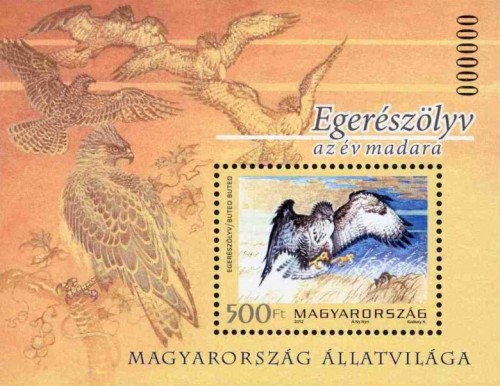
1. MAGYAR - MAGYARORSZÁG ÁLLATVILÁGA – BÉLYEGBLOKK - Bélyeg rendelési kód: 2012 év bélyegei kompletten
2. ENGLISH - THE FAUNA OF HUNGARY - BLOCK - Order code of the stamp: 2012 Year stamps complete
3. GERMAN - UNGARNS TIERWELT – BLOCK - Die Bestellnummer Der Marke: 2012 Jahr Briefmarken komplett
1. MAGYAR - MAGYARORSZÁG ÁLLATVILÁGA – BÉLYEGBLOKK
A 2012-es év madara, az egerészölyv bélyegblokkon
A Magyar Posta évente új bélyegsorozat és bélyegblokk kibocsátással mutatja be hazánk jellegzetes állatvilágát. Az idei újdonságokon ragadozó madarak láthatók. A 2012-es év madarát, az egerészölyvet ábrázoló bélyegblokk Székely Kálmán grafikusművész tervei szerint az Állami Nyomdában 80.000 példányban készült. A keretrajzon szereplő grafikai kompozíció a vadászó egerészölyv jellegzetes mozdulatait követi, amely a bélyegképen teljesedik ki. A blokkhoz tartozó – 2012. május 4-én kibocsátott – bélyegsorozat címletein a névértékek sorrendjében a parlagi sas, a rétisas, a kék vércse és a kerecsensólyom szerepel.
Az egerészölyv (Buteo buteo) a madarak osztályának vágómadár-alakúak rendjébe, ezen belül a vágómadárfélék családjába tartozó faj. Európa és Ázsia sík- és hegyvidéken szép számban előforduló gyakori ragadozó. Jelenléte a Kárpát-medencében állandó. A Magyar Madártani és Természetvédelmi Egyesület 2012-ben az év madarának választotta. A 2012. januárban végrehajtott madárszámlálás eredménye alapján 5183 egerészölyv telelt Magyarországon. Hazánkban védett, eszmei értéke 10.000 forint.
Testhossza nagyjából félméter, szárnyfesztávolsága ennek több mint duplája. Nehéz, közepes vagy nagy termetű, széles szárnyú és rövid farkú madár. A tojó nagyobb és testesebb a hímnél. Színezete változó, a sötétbarnától a majdnem fehérig terjed, ami egyedülálló az európai ragadozó madarak között. Főként kerítéskarókon és oszlopokon ül, vagy a felszálló légáramlatokon kering. Nyávogáshoz hasonlítható kiáltásokat hallat. Gyakran látni a nyílt kultúrtájak és erdőszélek felett vitorlázni, ilyenkor szárnya enyhe „V” alakban felfelé hajlik. Csak kis állatokra vadászik, főként pockokat fog, de gyíkokat, kígyókat, madárfiókákat és rovarokat is eszik. (Forrás: hu.wikipedia.org)
Forrás: Posta
2. ENGLISH - THE FAUNA OF HUNGARY - BLOCK
Birds of prey are this year’s new features. Állami Nyomda printed 80,000 copies of the block depicting the common buzzard, the 2012 bird of the year, based on the design by graphic artist Kálmán Székely. The graphic composition of the frame shows the characteristic movements of a hunting common buzzard, which can be seen in its full splendour in the actual stamp image. The stamps that accompany the block – issued on 4 May 2012 – depict in the rising order of their nominal values the eastern imperial eagle, the white-tailed eagle, the red-footed falcon and the Saker falcon. The common buzzard (Buteo buteo) belongs to the accipitriformes order of birds.
It is a bird of prey that can be found in high numbers in the plains and highlands of Europe and Asia. It has a permanent presence in the Carpathian Basin. In 2012 the Hungarian Ornithological and Nature Conservation Society selected it as the bird of the year. On the basis of the findings of a census carried out in January 2012, 5,183 common buzzards spent the winter in Hungary. The common buzzard is a protected species in Hungary with a value of 10,000 forints.
Its body length is approximately half a metre and its wingspan is more than double this. It has a heavy, me-dium or large body with wide wings and a short tail. The hen is larger and more bulky than the male. Its plumage varies from dark brown to almost white, which makes it unique among European birds of prey. It chiefly perches on fences and pillars or circles in upward air currents. Its cries can be compared to a mewing sound. It can frequently be seen gliding above open landscapes and the edges of forests with its wings folded upwards into a V shape. It only hunts for small animals and chiefly catches voles but it also eats lizards, snakes, fledglings and insects. (Source: hu.wikipedia.org)
3. GERMAN - UNGARNS TIERWELT – BLOCK
Der Mäusebussard, Vogel des Jahres 2012, auf Briefmarkenblock
Die Magyar Posta stellt jedes Jahr Ungarns typische Tierwelt in Form einer neuen Briefmarkenserie und eines neuen Briefmarkenblocks vor. Auf den diesjährigen Novitäten sind Greifvögel abgebildet. Der Briefmarkenblock, der den Mäusebussard, Vogel des Jahres 2012, abbildet, ist nach den Entwürfen des Grafikers Kálmán Székely in der Állami Nyomda (Staatsdruckerei), in einer Auflagenhöhe von 80 000 Exemplaren hergestellt worden. Die grafischen Kompositionen der Rahmenzeichnung und des Briefmarkenbildes zeigen typische Bewegungen des Mäusebussards bei der Jagd. Die Marken der zum Block gehörenden und am 4. Mai 2012 herausgegebenen Briefmarkenserie zeigen in der Reihenfolge ihres Nennwertes den Östlichen Kaiseradler, den Seeadler, den Rotfußfalken und den Würgfalken.
Der Mäusebussard (Buteo buteo) ist ein Greifvögel aus der Familie der Habichtartigen. Er ist der häufigste Vertreter dieser Familie in den Tiefebenen und Gebirgen Europas und Asiens. Im Karpatenbecken ist seine Präsenz ständig. 2012 wurde er von der Magyar Madártani és Természetvédelmi Egyesület (Ungarische Gesellschaft für Ornithologie und Naturschutz e.V.) zum Vogel des Jahres gewählt. Nach der Vogelzählung vom Januar 2012 überwinterten in Ungarn 5183 Mäusebussarde. In Ungarn ist er geschützt, sein Idealwert beträgt 10.000 HUF.
Er ist etwa einen halben Meter lang und seine Flügelspannweite ist mehr als doppelt so groß. Er ist ein kompakter, mittelgroßer oder großer Greifvogel mit breiten Flügeln und kurzem Schwanz. Die Weibchen sind größer und wiegen mehr als die Männchen. Seine Färbung variiert von fast vollständig schwarzbraun bis nahezu ganz weiß, was einzigartig in der Vogelwelt Europas ist. Mäusebussarde sitzen gerne auf Pfosten oder kreisen in den Aufwinden. Sein Ruf klingt miauend. Oft sind Mäusebussarde in kreisendem Segelflug über offenen Landschaften und kleinen Waldgebieten zu sehen, wobei die Flügel flach v-förmig aufgestellt werden. Die Hauptnahrung des Mäusebussards sind Kleinsäuger, vor allem Feldmäuse, er frisst aber auch Eidechsen, Schlangen, Jungvögel und Insekten. (Quelle. hu.wikipedia.org)










